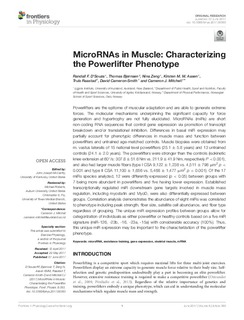| dc.contributor.author | D'Souza, Randall F. | |
| dc.contributor.author | Bjørnsen, Thomas | |
| dc.contributor.author | Zeng, Nina | |
| dc.contributor.author | Aasen, Kirsten M. M. | |
| dc.contributor.author | Raastad, Truls | |
| dc.contributor.author | Cameron-Smith, David | |
| dc.contributor.author | Mitchell, Cameron J. | |
| dc.date.accessioned | 2017-10-24T09:18:00Z | |
| dc.date.available | 2017-10-24T09:18:00Z | |
| dc.date.issued | 2017-06-07 | |
| dc.identifier.citation | Frontiers in Physiology. 2017, 8, 383. | nb_NO |
| dc.identifier.uri | http://hdl.handle.net/11250/2461675 | |
| dc.description | This is an open-access article distributed under the terms of the Creative Commons Attribution License (CC BY). The use, distribution or reproduction in other forums is permitted, provided the original author(s) or licensor are credited and that the original publication in this journal is cited, in accordance with accepted academic practice. No use, distribution or reproduction is permitted which does not comply with these terms. | |
| dc.description.abstract | Powerlifters are the epitome of muscular adaptation and are able to generate extreme forces. The molecular mechanisms underpinning the significant capacity for force generation and hypertrophy are not fully elucidated. MicroRNAs (miRs) are short non-coding RNA sequences that control gene expression via promotion of transcript breakdown and/or translational inhibition. Differences in basal miR expression may partially account for phenotypic differences in muscle mass and function between powerlifters and untrained age-matched controls. Muscle biopsies were obtained from m. vastus lateralis of 15 national level powerlifters (25.1 ± 5.8 years) and 13 untrained controls (24.1 ± 2.0 years). The powerlifters were stronger than the controls (isokinetic knee extension at 60°/s: 307.8 ± 51.6 Nm vs. 211.9 ± 41.9 Nm, respectively P < 0.001), and also had larger muscle fibers (type I CSA 9,122 ± 1,238 vs. 4,511 ± 798 μm2 p < 0.001 and type II CSA 11,100 ± 1,656 vs. 5,468 ± 1,477 μm2 p < 0.001). Of the 17 miRs species analyzed, 12 were differently expressed (p < 0.05) between groups with 7 being more abundant in powerlifters and five having lower expression. Established transcriptionally regulated miR downstream gene targets involved in muscle mass regulation, including myostatin and MyoD, were also differentially expressed between groups. Correlation analysis demonstrates the abundance of eight miRs was correlated to phenotype including peak strength, fiber size, satellite cell abundance, and fiber type regardless of grouping. The unique miR expression profiles between groups allow for categorization of individuals as either powerlifter or healthy controls based on a five miR signature (miR-126, -23b, -16, -23a, -15a) with considerable accuracy (100%). Thus, this unique miR expression may be important to the characterization of the powerlifter phenotype. | nb_NO |
| dc.language.iso | eng | nb_NO |
| dc.publisher | Frontiers Media | nb_NO |
| dc.subject | microRNA | nb_NO |
| dc.subject | resistance training | nb_NO |
| dc.subject | gene expression | nb_NO |
| dc.subject | skeletal muscle | nb_NO |
| dc.subject | mRNA | nb_NO |
| dc.subject | microRNA | |
| dc.subject | resistance training | |
| dc.subject | gene expression | |
| dc.subject | skeletal muscle | |
| dc.subject | mRNA | |
| dc.title | MicroRNAs in muscle: characterizing the powerlifter phenotype | nb_NO |
| dc.type | Journal article | nb_NO |
| dc.type | Peer reviewed | nb_NO |
| dc.rights.holder | © 2017 D'Souza, Bjørnsen, Zeng, Aasen, Raastad, Cameron-Smith and Mitchell. | |
| dc.source.journal | Frontiers in Physiology | nb_NO |
| dc.identifier.doi | 10.3389/fphys.2017.00383 | |
| dc.description.localcode | Seksjon for fysisk prestasjonsevne / Department of Physical Performance | nb_NO |
| dc.description.localcode | Seksjon for fysisk prestasjonsevne / Department of Physical Performance | |
